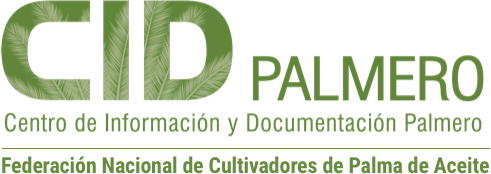Nutrient contents in different structures of OxG hybrid palms under commercial conditions of nursery

Author
Rincón Numpaque, Álvaro Hernán
Garzón González, Edna Margarita
Cristancho Rodríguez, José Álvaro
Estadisticas
Publicación:
Revista Palmas; Vol. 33 Núm. 1 (2012); 11-21
0121-2923
Revista Palmas; Vol. 33 Núm. 1 (2012); 11-21
0121-2923
Abstract
In Colombia there are planted almost 23,000 ha of O×G hybrid. Up to date, there are few studies on the nutrient requirement of O×G hybrid. The aims of this study were: i) to quantify the partition of elements in the different structures of the hybrid seedlings and ii) to calculate the actual nutrient use efficiency at the nursery stage. A simple randomized sampling was carried out. Seven representative soils were selected and analyzed. Different morphological traits were measured and various elements were analyzed from the tissue of different structures of 10 months old seedlings. Additionally, the fertilizer schedule and rates was registered, in order to calculate the apparent nutrient recovery. The result from the nursery study showed that N, K and Mg leaf content were lower (12 to 18%) in O×G hybrid, in contrast to the commercial oil palm D×P. The phosphorous and calcium content was similar. There was found that leaves nutrient content was influenced by: the soil, origin of the seeds and the fertilizers schedule of the plantations. The ranking for the nutrient contents in the plant was N > K > Ca > Mg > P > S. There was a high variation in B leaf content (11-86 mg/kg). By the other hand, it was found that the nutrient efficiency was low (< 43.8%). The significant differences found on the nutrient content between O×G and D×P palms and the low nutrients use efficiencies showed the need to further detailed studies at the nursery stages to adjust the nutrition’s plans and reduce the management costs. En Colombia hay sembradas cerca de 23.000 hectáreas de híbridos OxG. A la fecha, existen pocos estudios sobre los requerimientos de nutrimentos de estos materiales. Los objetivos de este estudio fueron (a) cuantificar la distribución de elementos en las diferentes estructuras de plátulas híbridas OxG y (b) calcular la eficiencia actual de la fertilización en etapa de vivero. Para esto se llevó a cabo un muestreo aleatorio simple. Se seleccionaron y analizaron varios elementos en los tejidos de diferentes estructuras de plántulas de 10 meses de edad. Adiconalmente, se registraron las dosis de aplicación de nutrimentos, a fin de calcular la eficiencia de su uso. Los resultados del estudio en vivero permitieron observar que los contenidos de nitrógeno, potasio y magnesio foliar fueron menores en híbridos OxG que en plántulas DxP (<12 a 18%). Los contenidos de P y Ca fueron similares. Se encontró que los niveles de nutrimentos estuvieron influenciados por el tipo de suelo, el material de origen y las dosis de fertilizantes aplicados. El orden de los contenidos de nutrimentos en la plata fue N > K> Ca> Mg > P> S. Se encontró una alta variación en los contenidos de B foliar (11-86 mg/kg). Por otra parte, se observó que la eficiencia de fertilización fue baja (<43,8%). Las diferencias significativas encontradas en el contenido de nutrimentos entre palmas OxG y DxP y las bajas eficiencias de uso, muestran la necesidad de realizar estudios detallados en etapa de vivero para ajustar los planes de nutrición y disminuir los costos de manejo.
In Colombia there are planted almost 23,000 ha of O×G hybrid. Up to date, there are few studies on the nutrient requirement of O×G hybrid. The aims of this study were: i) to quantify the partition of elements in the different structures of the hybrid seedlings and ii) to calculate the actual nutrient use efficiency at the nursery stage. A simple randomized sampling was carried out. Seven representative soils were selected and analyzed. Different morphological traits were measured and various elements were analyzed from the tissue of different structures of 10 months old seedlings. Additionally, the fertilizer schedule and rates was registered, in order to calculate the apparent nutrient recovery. The result from the nursery study showed that N, K and Mg leaf content were lower (12 to 18%) in O×G hybrid, in contrast to the commercial oil palm D×P. The phosphorous and calcium content was similar. There was found that leaves nutrient content was influenced by: the soil, origin of the seeds and the fertilizers schedule of the plantations. The ranking for the nutrient contents in the plant was N > K > Ca > Mg > P > S. There was a high variation in B leaf content (11-86 mg/kg). By the other hand, it was found that the nutrient efficiency was low (< 43.8%). The significant differences found on the nutrient content between O×G and D×P palms and the low nutrients use efficiencies showed the need to further detailed studies at the nursery stages to adjust the nutrition’s plans and reduce the management costs.
Palabras clave:
hybrids
nutrient levels
bud not
fertilization efficiency
nursery
oil palm
híbridos
niveles de nutrimentos
pudrición del cogollo
eficiencia de la fertilización
vivero
palma de aceite
hybrids
nutrient levels
bud not
fertilization efficiency
nursery
oil palm
híbridos
niveles de nutrimentos
pudrición del cogollo
eficiencia de la fertilización
vivero
palma de aceite


